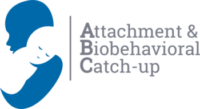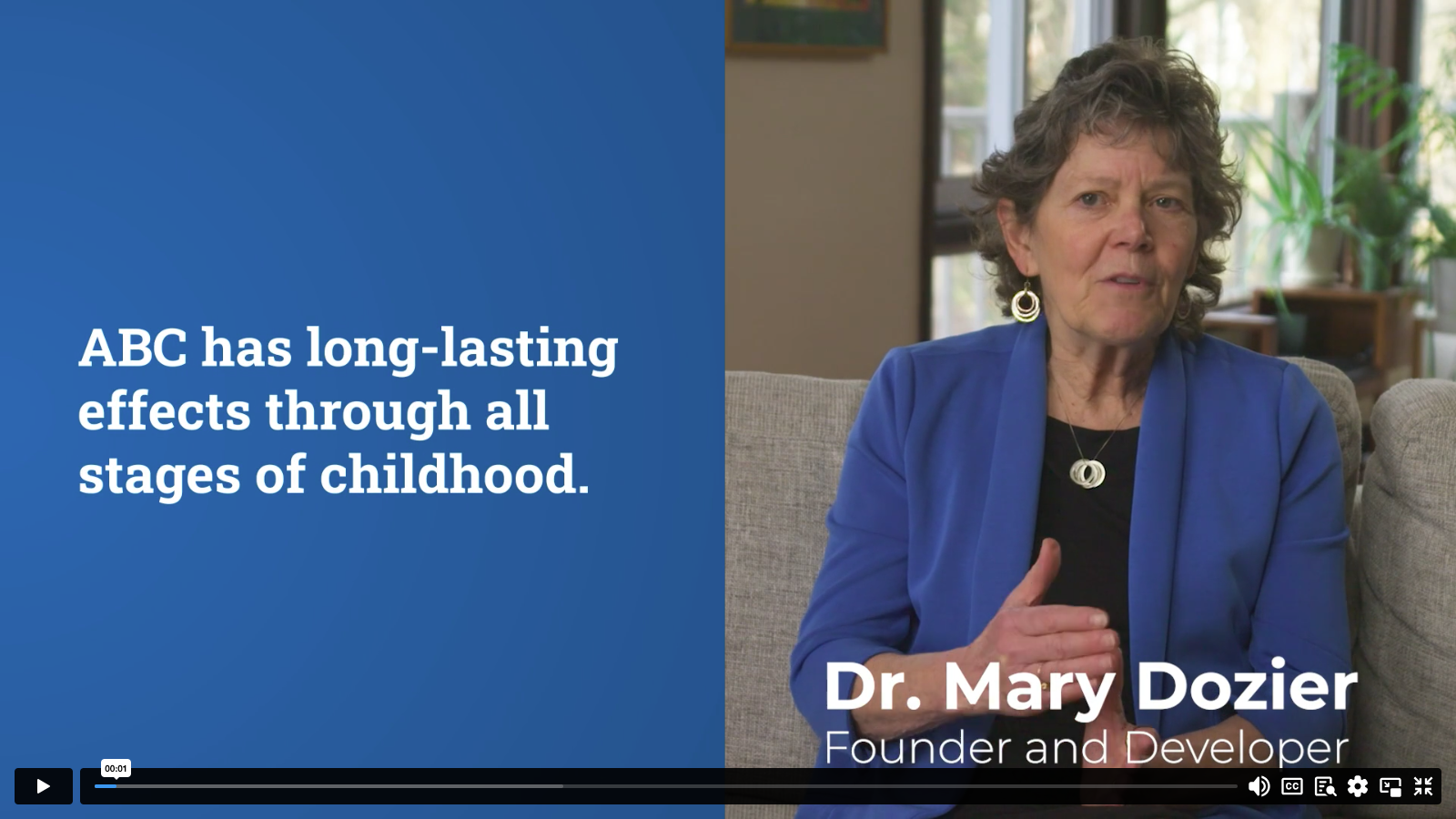Research Supporting ABC
We have tested the efficacy of the ABC Intervention through randomized clinical trials with birth parents involved in the child welfare system as part of a foster care diversion program, with foster parents, and with parents adopting internationally. In each study, parents have been randomly assigned to receive the ABC intervention or a control intervention. Parents and evaluators have been blind to the experimental condition. Most of the findings described below are from the high-risk Child Protective Services (CPS) involved families, which is our longest running study. When it involves a different sample, we indicate that.
We have found evidence supporting the efficacy of ABC in these three independent samples, suggesting that ABC is effective in improving attachment and helping regulate both biology and behavior in at-risk children. We and others have also found early evidence supporting the efficacy of ABC at dissemination sites across the country.
Effects of ABC in Early Childhood
Attachment
Among CPS-involved children, more of the children whose parents received the ABC intervention were classified as having secure attachments than those in the control group (52% of children receiving ABC vs. 33% of children receiving a control intervention). In addition, fewer of the children in the ABC intervention group had disorganized attachments than those in the control group (only 32% of ABC children were classified as disorganized vs. 57% of children in the control group) (Bernard, Dozier, Bick, Lewis-Morrarty, Lindhiem, & Carlson, 2012).
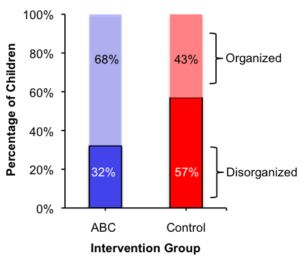
Cortisol regulation
Children who received the ABC intervention had a more normative diurnal pattern of cortisol production (steeper slopes and higher wake-up values of cortisol) than children who received the control intervention (Bernard, Dozier, Bick, & Gordon, 2015).
When assessed three years after completing the ABC intervention, children who received the ABC intervention continued to have a more normative diurnal cortisol pattern than the children who had received the control intervention (Bernard, Hostinar, & Dozier, 2015).
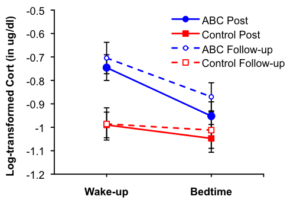
Self-regulation: Emotion expression
When children were between 24 and 36 months of age (1-2 years after the intervention), children participated in a challenging task designed to elicit frustration. Children who received the ABC intervention displayed less overall anger, and less anger towards their parents in particular, than children who received the control intervention (Lind, Bernard, Ross, & Dozier, 2014).
Attachment Self-regulation: Executive functioning & Inhibitory control
Between 4 and 6 years of age (2-4 years after the intervention), foster children who received the ABC intervention had stronger executive functioning and better inhibitory control than foster children in the control group. In addition, when looking at these skills, the foster children who had received ABC did not differ significantly from the comparison group of children who had never been involved with the foster care system (Lewis-Morrarty, Dozier, Bernard, Terraciano, & Moore, 2012; Lind, Raby, Caron, Roben, & Dozier, 2017).
More specifically, when asked to sort cards according to a particular dimension (e.g., shape) on the Dimensional Change Card Sort, children across both groups performed well. However, after being asked to change dimensions by which they were sorting (e.g., sort by color), children from the ABC intervention group showed significantly better performance than children in the control group. Being able to switch dimensions is associated with other executive functions, such as planning and inhibitory control, and deficits in executive functions are associated with disorders such as ADHD (Mulas et al., 2006).
Inhibitory control refers to the ability to inhibit a dominant (or pre-potent) response and instead behave in a different way that is appropriate to the circumstances. Inhibitory control is key to children’s success in preschool and kindergarten – indeed, it is more important than having emerging literacy and numeracy skills. For example, children need to sit at their desks (or in circle, etc.) and inhibit the impulse to jump up and look out the window as other children play outside. When they fail to have this ability, they are often identified as having behavioral problems.
We tested children’s inhibitory control in a challenging task. Children were shown an attractive array of toys, but asked not to touch the toys, but rather to color in a coloring book. Children whose parents received the ABC intervention showed better inhibitory control than children in the control condition. Fewer of the children in the ABC group touched the toys, and those who did touch the toys waited longer on average to do so than children in the control group (Lind, Bernard, Yarger, & Dozier, in press).
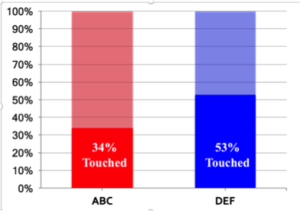
Verbal abilities
Foster children whose parents had received the ABC intervention had higher vocabulary scores (as assessed through the Peabody Picture Vocabulary Test: PPVT) than children whose parents had received a control intervention (Bernard, Lee, & Dozier, 2017). ABC children had a mean standard score of 98.1 (scoring at the 45th percentile) and children who received the control intervention had a mean standard score of 88.1 (scoring at the 28th percentile).
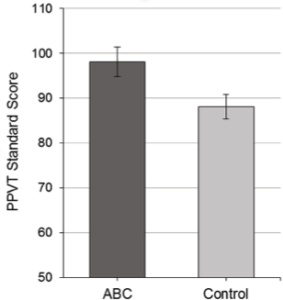
In an extension and replication of these findings with a different sample, we examined whether parental sensitivity mediated the effects of the ABC intervention on foster child language abilities. We found that the intervention had effects on children’s language abilities, and that this effect was fully mediated by parental sensitivity (Raby, Freedman, Yarger, Lind, & Dozier, 2018).
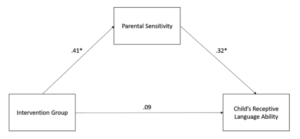
Effects of ABC in Middle Childhood
We are now following children into middle childhood (8-10 years).
Attachment
At age 9 (7- 8 years after the intervention), children with whom we had intervened in infancy were asked to complete a self-report inventory that asks children to respond to 15 questions about their relationships with their parents (Kerns, 2001). Children indicated which one of two statements best describes them, such as “Some kids find it easy to trust their mom,” or “Other kids are not sure they can trust their mom,” and then to indicate if the statement they choose is “really like you” or “sort of like you.”
We found that children whose parents received the ABC intervention reported attachments to their parents that were significantly more secure (M = 3.49, SD = .38) than children whose parents received the control intervention (M = 3.28, SD = .47; Raby et al., in preparation).
Self-regulation: Autonomic nervous system activity
To assess whether children in the ABC intervention showed better-regulated autonomic nervous system activity, we had 9-year-old children engage in a challenging discussion with their parents that was designed to elicit negative emotions. Physiological data were recorded from sensors that monitored heart rate and breathing while children were at rest while they discussed a recent distressing event with the parent, and then while having a positive discussion.
Children in the ABC group showed lower heart rate and higher levels of respiratory sinus arrhythmia (RSA), reflecting better regulation of their autonomic nervous system, than children in the control group (see figure; Tabachnick et al., under review).
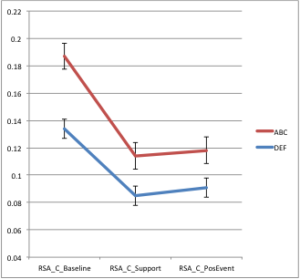
Neural activity
Electroencephalography (EEG) permits the assessment of neural function. As the cortex becomes more differentiated and specialized during development, there is a reduction in the proportion of low frequency band activity and increase in the proportion of high band frequency activity (high alpha and beta activity). Bick et al. (2018) found that children who had received the ABC intervention showed higher relatively beta activity than control children, consistent with a more mature cortex.
Brain activity
We also examined children’s brain activation through functional magnetic resonance imaging (fMRI) in each of two tasks when children were between 9 and 11 years old. In one task, children viewed photos of neutral and fearful faces.
The children with histories of CPS involvement showed more occipital cortex and fusiform gyrus activation when viewing fearful than neutral faces than a group of low-risk children, regardless of whether they were in the ABC or control group (Valadez, Tottenham, & Dozier, in preparation). However, children from the ABC group showed more prefrontal cortex and insula activation than children from the control intervention. This suggests that even though at some level ABC children are as threat-sensitive as control children, what differentiates ABC children is greater prefrontal cortex involvement, and thus better regulation of the threat.
In a second fMRI task, children viewed photographs of their own mothers and other women with both neutral and smiling faces. Children in the ABC group showed greater activation of brain regions involved in face processing and attention when viewing photographs of their own mothers than strangers, relative to children in the control group (Valadez et al., in preparation). These results are consistent with their mothers having a more salient role psychologically for these children than for control children.
Effects of ABC on Parents
The intervention appears to be powerful in changing children’s behaviors, and in sustaining change over time. This could only occur if parents are also changing. We posited parental sensitivity as the intervention mechanism.
Parental sensitivity
Sensitivity, or when a caregiver is able to notice, understand, and respond appropriately to a child’s cues, is especially important for children who have experienced early adversity. Immediately following the intervention and three years after the intervention was completed, ABC parents showed higher sensitivity (followed their children’s lead more), showed more positive affect (delight), were less detached, and were less intrusive than control intervention parents (Bick & Dozier, 2013). ABC parents looked nearly indistinguishable from a low-risk comparison group of parents.
These effects have been replicated with multiple samples, as well as in dissemination sites (e.g., Roben, Dozier, Caron & Bernard, 2017; Yarger, Hoye, & Dozier, 2016).
Parents’ secure base script knowledge
Harriet and Everett Waters (2006) proposed that individuals’ histories of experiences with attachment figures are consolidated and represented in memory as a “secure base script,” consisting of temporal-causal elements that characterize secure base interactions.
Parents assigned to the ABC intervention showed higher secure base script knowledge than parents assigned to the control intervention. Parents in the control group were significantly lower in secure base script knowledge than a low-risk comparison group; and the ABC and low-risk groups did not differ significantly (Raby, Zajac, and Dozier, in preparation). Further, parents’ secure base script knowledge scores were positively correlated with parental sensitivity scores during parent-child interaction tasks.
Parents’ brain activity
Differences in brain activity, assessed with event related potentials (ERPs), were seen between parents in the ABC intervention and those in the control intervention several years post-intervention. A previous study by Rodrigo (2010) had demonstrated that neglecting mothers failed to show differential neural activity when viewing different affective expressions of babies, despite being able to report seeing the faces accurately. We sought to replicate those results, but demonstrate that ABC mothers showed differentiated neural activity. As predicted, parents in the ABC intervention showed differentiated brain responses (N170 and LPP) to child facial affect whereas parents in the control intervention did not show such differentiated brain activity (Bernard, Simons, & Dozier, 2015).
We also tested associations between ERP responses and observed maternal sensitivity. Mothers who showed larger differences between ERP responses to emotional faces and neutral faces were more sensitive during their interactions with their children than mothers who showed smaller differences. These changes in maternal brain activity and behavior were observed approximately 3 years after parents participated in ABC.
Effects of ABC Dissemination
-Parents seen by community-based clinicians in Hawaii showed improvements from pre-to post-intervention in sensitivity, delight, and intrusiveness (Caron, Weston-Lee, Haggerty & Dozier, 2016). Frequency and quality of the hypothesized active ingredient of ABC, in the moment comments, predicted parent behavior change, as well as likelihood of early dropout, in this sample (Caron, Bernard & Dozier, 2016).
-Large effect sizes for parent behavior change have also been found in a larger sample of 108 parents seen by 37 parent coaches in 5 dissemination sites (Roben, Dozier, Caron & Bernard, 2017).
-In a small community-based randomized clinical trial, families who participated in ABC had lower scores on child abuse potential, parenting stress, and child internalizing and externalizing behaviors than families who were in a wait-list control condition (Sprang, 2009).
-In a second small community-based RCT testing for intervention effectiveness for new mothers receiving residential substance abuse treatment, mothers who participated in ABC demonstrated more sensitive parenting behaviors than mothers in the control group (Berlin, Shanahan, & Appleyard Carmody, 2014).
-In a third community-based RCT, in a primarily Latina sample (87% percent), parents received a combined treatment of ABC and Early Head Start, or Early Head start alone. Participants who completed the enhanced treatment of ABC and Early Head Start together showed more change in maternal sensitivity, intrusiveness, and positive regard than those parents who had received Early Head Start alone (Berlin, Martoccio, & Jones Harden, in press). Qualitative research with this sample also found ABC to be feasible, of value, and culturally relevant to the primarily Latino community (Aparicio, Denmark, Berlin, & Jones Hardin, 2016).
For more information regarding our references, please contact us.
